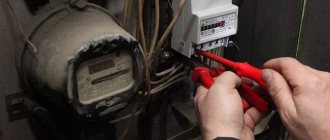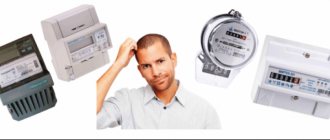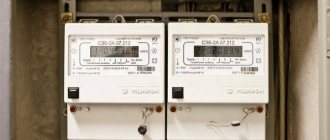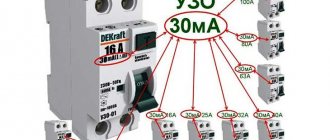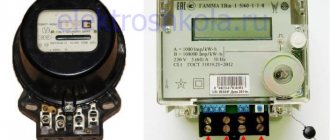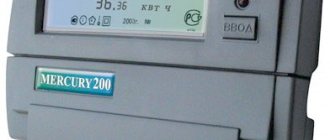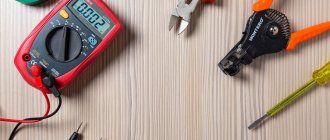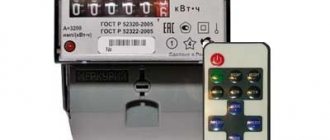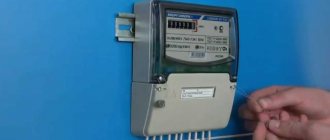Today we will talk about metering devices and which electric meter is best to install in an apartment. Theoretically, the meter is the responsibility of the company that sells you electricity, but in practice, this issue has to be resolved by the residents of the house or apartment. You are required to have a metering device and replace it as needed, for example, if it is old and does not meet modern requirements.
And here a big question arises - how to choose an electric meter for an apartment? If you can’t count them, like mosquitoes in summer. Offhand, any experienced electrician will name you a couple of dozen manufacturing companies from Russia and neighboring fraternal republics.
But even the coolest of us will not remember all the types, because there are more than four hundred names. And this is without imported electricity meters from Europe. In short, your eyes widen and your head spins if you need to buy an electric meter for an apartment, and even the price is a secondary issue.
So, we decided to write instructions on how to choose an electricity meter for an apartment or house.
Electricity meter for an apartment - design and characteristics
To understand how to choose, you need to know what we are choosing. As the rabbit in Winnie the Pooh said: “I come in different forms!”, the same picture applies to counters.
Induction and electronic
First of all, metering devices are divided by design.
Induction counter
was invented a long time ago and until recently only it was used. This is a familiar disk drive that is located on the site or right in the apartment. Inside such a device there are two magnetic coils, current and voltage. Their magnetic field rotates a disk connected to a counting mechanism, which takes into account the kilowatts used.
A distinctive feature of the induction meter is its reliability and long service life. According to the passport, at least 15 years, but in fact, such “electricity accountants” have been quietly working for 30-50 years. But the accuracy of the measurement is rather weak, as they say, only large fish are caught, and weak loads are missed.
Electronic counter
measures flow directly and appeared not so long ago. There are no moving measuring parts in it; consumption data is shown on the indicator board. An electronic recorder can store consumption figures and transmit them, for example, in automated smart home systems.
New devices can calculate energy consumption at several tariffs with high accuracy. Which, by the way, can be increased if you replace the microcircuit. Everything is taken into account, even the most minimal load from equipment in sleep mode.
Manufacturers promise that they will work for at least 10-15 years, but so far none have reached this age; they appeared only recently. As for reliability, we can say that the electronics can be glitchy, but in general, if done well, it works just as well.
Single-phase or three-phase meter for an apartment
Since electrical networks are single-phase, with a voltage rating of 220 V, and three-phase, with a voltage of 380 V, meters are produced in different types.
Most apartment residents have a single-phase electric meter. Our household electrical networks are designed for 220 Volts, as are home electrical appliances. Is a three-phase meter needed in an apartment with a single-phase network? More likely no than yes. Theoretically, if installed, it will keep track of electricity correctly. But the energy sales organization will simply refuse to register it.
A three-phase meter is usually needed in a private home. Much of the equipment there (boilers, water heaters, electric motors) runs on a three-phase network with a voltage of 380 V. There is also a 220-volt electricity meter in the house. He calculates the consumption of a single-phase network, that is, he is responsible for lighting and working irons, kettles, washing machines, TVs, etc.
Advice!
For an apartment, it is enough to buy a single-phase electronic electricity meter.
Energy meter TsE6803V 1 230V 3ph.4p. M7 P32 5(60) A
The three-phase single-tariff electricity meter Energomera TsE6803V is used both in the public sector (mobile structures, public and residential buildings, garages, cottages) and in industrial and commercial enterprises. It can be connected to AC power directly or through transformers.
The device is designed to operate at a rated current of 5 A, with a maximum current of 60 A. The manufacturer claims an increased service life of an impressive 30 years, but the warranty is only for 7 years from the date of creation of the meter.
Advantages:
- economical energy consumption;
- low price;
- ease of repair and replacement of meters;
- resistance to weather influences and mechanical damage;
- light indication during operation;
- presence of telemetric pulse output.
Flaws:
- mechanical scoreboard.
What kind of meter is needed for the apartment - multi-tariff or single-tariff
Previously, all metering devices were induction and single-tariff. With the advent of electronic ones, it became possible to count consumed electricity at several tariffs - two, three or more.
A multi-tariff registrar calculates consumption by time, for example, a two-tariff one for the day zone - from 7 am to 11 pm and for the night zone - from 11 pm to 7 am.
Daytime energy is more expensive, nighttime energy is cheaper, therefore, you can schedule the operation of energy-intensive equipment at night. Start washing there or turn on the heater. Profitable? Yes, but here's the story. The difference in day and night tariffs is large in some places, and practically none in others, but a multi-tariff meter is always more expensive than a single-tariff meter.
Therefore, before choosing to pay at several rates, estimate your monthly expenses and break them down into day/night periods. And then calculate according to one tariff. If the savings are half of the single-tariff payment or at least a third, then it makes sense to install a multi-tariff device. It will pay for itself and save your money.
If the difference is 100-200 rubles, then there is no point in bothering with multi-tariff payments. The equipment will not pay for itself soon and the savings are purely symbolic. In this case, it is better to think about smart energy management.
A multi-tariff electricity meter for a home must also be selected based on consumption and taking into account the equipment with powerful electrical equipment. If a water heater or partial electric heating is working, then it is more profitable to use them as much as possible at a cheap nightly rate.
Typeit NEVA 303 1S0 230V 5(60) A 5(60) A
The single-tariff, three-phase electricity meter Typeit NEVA 303 1S0 230V is used to account and measure the consumption of electrical energy at one tariff in a 3- and 4-wire AC network. The meter base has a spring-loaded clamp and a steel spring in it allows the latch to operate continuously even in adverse weather conditions (such as low temperature).
The meter specification indicates 280,000 hours of operation before failure. The warranty is provided for a full 7 years.
Advantages:
- 1 accuracy class;
- indicator of operation of the measuring device in each phase;
- reliable standard mounting on TN35 rail;
- ease;
- the presence of an electromechanical counting mechanism (EMOU);
- electrical test output of active electricity.
Flaws:
- high cost;
- fragile body.
How to choose an electricity meter for your home according to accuracy class
Electric meters differ not only in design and number of tariffs, but also in accuracy class. Any device has a measurement error. The accuracy class is the maximum error.
According to modern requirements, an electric meter in an apartment or house must have an accuracy class of 2.0 or lower.
That is why they are forced to change old induction devices, which have an accuracy class of 2.5%. What's the practical point? The higher the error rate, the more the device will miss a weak load and will not count it. For example, many home electrical appliances are in standby or sleep mode part of the time. The energy consumption is small, but it is still there. A meter with a lower error (1-2%) will calculate such consumption, but a meter with a high error (2.5%) will simply not notice it. This is beneficial for the consumer, but not at all beneficial for energy sales. The undercount turns out to be quite significant.
On the other hand, if you “plug in” a device with an accuracy class of 0.2% instead of two, you will create a holiday for energy sales and a problem for yourself. Your accurate meter will “give” inflated consumption readings. In essence, you will be paying for yourself and your neighbor.
Our advice!
Take an electric meter for your house or apartment with an accuracy class of 2.0. The requirements indicate an “upper limit” of error - use this. Send everyone who is forced to install the device with greater accuracy to read the rules.
Evaluation of the metering device when choosing
Meter design type
There are only two types, differing in operating principle.
- Induction mechanical meters were once ubiquitous and familiar to everyone. The electric current passing through the meter induces an electromagnetic field, which causes the disk, which is probably so familiar to everyone, to rotate. Each revolution of the disk corresponds to a certain amount of current consumed. The rotation of the disk is mechanically transmitted to a counting device, from which the owners read the readings.
Such devices are highly reliable - they last for decades without requiring repairs. Their cost is also low, which often becomes a decisive selection criterion. Disadvantages include large measurement errors. However, modern models of such metering devices fit well into the established accuracy standards.
Another disadvantage is that such meters cannot be used for multi-tariff consumption metering.
- In electronic meters, “information processing” is carried out by a special processor circuit. The passage of current generates a pulse signal, which is transmitted to the adding device. This allows you to significantly increase the accuracy of measurements and reduce the dimensions of the device itself. However, in size, many electronic meters are in no way inferior to induction ones.
Indications may vary. In many models, the usual mechanical type circuit is retained, with a set of “wheels” scales, by analogy with induction devices. In others, almost similar in other characteristics, a digital display is installed.
Meter models from the same manufacturer are similar in layout, size and operational characteristics, but differ in the reading indication system
When choosing an indication system, everyone decides for themselves (unless, of course, we are talking about a single-tariff device) - whichever is more convenient for them. For example, it is believed that for switchboards located on the street, it is better to purchase a model with an electromechanical indication. For devices that will be installed indoors, there is no difference, but it is more convenient to read readings from a digital display.
The disadvantages of electronic meters are their shorter service life, and this is against the backdrop of a higher price for the device itself. However, judging by the technical characteristics of popular models, this accusation is completely unfounded, and high-quality electronic meters serve no less than induction ones.
There is no need to wait for clear recommendations. But if the load in the apartment is low and the average monthly consumption is small, then it is quite possible to purchase a regular inexpensive induction device. If consumption is quite high and, naturally, if you want to switch to differentiated tariffs, you purchase an electronic one.
Number of phases
The devices can be designed for operation in a single-phase network of 220 V, or in a three-phase network - 380 V. As a rule, since we are talking specifically about apartments, three-phase options are not considered.
True, the apartment can be in a “house on the ground”. In this case, you will have to clarify which network is being used.
By the way, a three-phase meter is quite capable of operating in a 220 volt network. But reverse replacement is impossible.
Device current class
Here we must proceed from real needs and the diameter of the wiring that fits the meter. Many older models of metering devices were designed for low simultaneous loads, and often this circumstance becomes the reason for the need for replacement.
Single-phase meters can be produced with permissible current ranges from 5 to 80 amperes. For three-phase ones, this figure can reach up to 100.
As a rule, for an apartment with a fairly serious equipment of household appliances, the best option is to purchase a meter with current ranges from 5 to 50 amperes. This corresponds to a copper wire with a diameter of 6 mm. It is very difficult to imagine a situation where a simultaneous load in an apartment will require more than 10 kW (and 50 amperes at 220 volts is even about 11 kW of power).
In the vast majority of cases, a meter with a permissible current range from 5 to 50 amperes will be sufficient for an apartment. If the owners have any doubts, it is recommended to consult a good electrician.
No one is stopping you from purchasing a meter with higher permissible current ratings. The question is how justified this will be, since the cost of the device will become significantly higher.
Possibility of differentiated consumption metering
This is also one of the common reasons for purchasing a new meter. Apartment owners come to the conclusion that it would be more profitable for them to switch to a differentiated payment scheme for consumed energy. Therefore, the device itself must have a similar function.
Such meters can be two-tariff and multi-tariff. What is the difference?
This device is capable of keeping separate records of consumption only for two specified time periods
The two-tariff system, of course, is able to keep track of consumption only for two periods - night and day. A more complex option also provides, for example, for dividing the daily period into peak and semi-peak consumption zones. That is, in such devices it is possible to use three or even more (in some models - up to eight) separate accounting periods, both by hour of the day and by day of the week.
The capabilities of this model are wider - it is capable of calculating energy consumption at four tariffs
It is clear that electric meters with differentiated consumption metering will cost much more than conventional ones. How justified are both such a purchase and the transition to a similar type of payment for electricity? It would seem that the money spent on the purchase should soon pay off.
It is impossible to give universal recommendations on this matter. The owners of the apartment must make a decision themselves, but before that, carefully analyze the normal way of life that has developed in the family. Consider which appliances use them for maximum energy consumption, and how you can change their operating mode in order to achieve savings through lower tariffs. The fact is that in some regions tariff plans are designed in such a way that a decrease in the “night” cost of a kilowatt is accompanied by an increase in the “day” cost, which becomes higher than the usual “flat scale” tariff. It is possible that you may not only not benefit from such a transition, but also receive more serious bills to pay.
For example, look at the tariffs of one of the central regions of Russia for 2022:
| Electricity consumption time | Cost 1 kW/h |
| Regular tariff plan, without gradation by time of day | |
| Flat rate, regardless of time of day | RUB 3.53 |
| Two-tariff differentiated plan | |
| Day rate, from 7.00 to 23.00 | 4.06 rub. |
| Night rate, from 23.00 to 7.00 | 1.46 rub. |
| Three-tariff differentiated plan | |
| Peak consumption tariff, from 7.00 to 10.00 and from 17.00 to 21.00 | 4.59 rub. |
| Half-peak tariff, from 10.00 to 17.00 and from 21.00 to 23.00 | RUB 3.53 |
| Night rate, from 23.00 to 7.00 | 1.46 rub. |
Note: Electricity tariffs by region of the country may vary significantly. The table above is provided as an example only.
Look here. If you don’t actively use the most powerful electrical appliances in terms of energy consumption at night, then you won’t see any benefit at all, and you can even work at a loss.
For example, modern refrigerators have a very low consumption class. There is no point in running electric heaters at full power at night - the heat is not conducive to healthy sleep. That is, tangible savings can only be achieved if you postpone washing overnight (if possible), heat a large volume of water in the boiler, and operate the dishwasher.
In a word, you will have to carefully calculate everything so as not to pay a lot of money for a completely unnecessary metering device, the payback of which will be doubtful or will become a reality in a few years.
Electric meter accuracy class
This parameter is regulated by Chapter X of the Decree of the Government of the Russian Federation dated May 4, 2012, as last amended as of December 30, 2017. In particular, Article 138 states that consumer consumption meters must have an accuracy class of at least “2”. Collective metering meters in apartment buildings (in the section of competence zones of network management and intra-building networks) - class no less than “1”, but this is no longer relevant to a specific apartment.
If, at the time of entry into force of this legislative act, a meter with a lower accuracy class (for example, “2.5”) was installed, then it is allowed to operate until the end of the inspection interval, the complete expiration of its service life, or until it fails (whichever comes first) . And then – it is still necessary to replace it with a class of at least 2.
By the way, meters with a lower accuracy class have already been discontinued, and it is still impossible to purchase and install them.
The accuracy class is usually indicated on the front panel of the meter with a number circled
Is it worth pursuing a higher class for “1” or even “0.5”? To be honest, this doesn't make much sense if the average consumption level is low. The accuracy class shows the possible error of the device, expressed as a percentage. That is, for example, with a consumption of 120 kW, the error can be only 2.4 kW per month - completely insignificant. Moreover, the discrepancy may even be in favor of the consumer.
It’s a different matter if you have to operate with more significant indicators of consumption. For example, with 1000 kW, the error not in favor of the owners can amount to all 20 kW. This means there is something to think about.
One more nuance. The Government Resolution mentioned above is the main document. That is, no one has the right to force the apartment owner to purchase a meter of a higher accuracy class if this seems unprofitable to him for reasons of the cost of the device. He has every right to limit himself to “two”.
Layout of the meter and method of its installation in a panel or cabinet
Almost all electric meters of the old style had a common characteristic shape. This is a cylindrical block placed on a trapezoidal platform. Many models have retained this layout - convenient if the device has to be installed in an old-style electrical panel.
Such devices are fastened with three screws located at the vertices of a triangle, the dimensions of which are established by the standard. The shield has counter holes, and installation is carried out without much difficulty.
Standard dimensions of the “old layout” meter and mounting holes in the panel panel for installing the device
Another option is meters designed for installation in more modern electrical panels on a DIN rail. Such devices are usually rectangular box-shaped, and at the back they have a special groove with a latch. Installation of such models is even easier.
Example of dimensions of a meter designed for installation in a cabinet with a DIN rail
By the way, many device manufacturers practice producing meters that are completely identical in their operational parameters, but differ precisely in the layout and method of installation in the panel (cabinet).
Almost the same model in terms of its characteristics, but with a difference in layout and installation method
The required option, of course, is selected taking into account the specific location where the meter will be installed.
Meter release date and test interval
In accordance with current rules, any electricity metering device, after assembly in production, undergoes mandatory state verification of measurement accuracy. After this, the device is sealed with a seal indicating the date of inspection. When purchasing, be sure to pay attention to the integrity of this seal. Otherwise, employees of the energy supplier company have the right to refuse to install and register the meter.
When purchasing a meter, be sure to pay attention to the integrity of the factory seals
Next important point. There are time limits within which issued meters can be installed without additional inspection. For single-phase metering devices it is two years, for three-phase meters it is one year.
That is, when purchasing a meter, the date of its release must be checked. If the device is “overdue,” then it will either be refused installation, or you will have to send it for an unscheduled inspection, naturally, at your own expense.
It wouldn’t hurt to clarify the inspection interval established by the manufacturer. For some electronic type meters it is relatively small, that is, scheduled checks will be carried out more often. Induction models are more convenient in this regard, since their interval can reach 16 years.
Additional meter selection criteria
It is clear that such devices should be purchased exclusively in specialized stores. Often, an energy supplier company offers a certain range of devices - this can be clarified, for example, on its website. If there is no such information resource, then you should still ask the company’s employees which devices they recommend for installation and which they simply will not deal with.
- The completeness of the device must be checked. Any meter is accompanied by a passport (form) with a stamp indicating that it has passed control. The document must be completed and certified in the prescribed manner. The form must specify both the maximum service life of the device and the value of the inspection interval.
The technical documentation accompanying the metering device must be completed and certified accordingly
- Any energy meter, no matter whether it is domestic or foreign, must be listed in the State Register, that is, be certified and approved for use on the territory of the Russian Federation.
- When choosing a device, you can pay attention to some additional points:
— The meter can be designed for any operating temperatures or only for installation in a heated room.
— Some devices show quite sensitive noise levels. If this is important, that is, the meter will be installed in a residential area, then this point should be clarified when choosing.
— It is possible that the energy supplier company has implemented or is planning to introduce an automatic consumption metering system in the near future. This means that you will need to purchase a meter with built-in feedback channels (GSM, IP or PLS). This point should also be clarified in advance so that you do not have to purchase a more advanced device in the near future.
— Modern models of meters can be equipped with additional functions. This includes the ability to take instant current readings of voltage, current, active and reactive power. The built-in memory cells of the device can store information about energy consumption by month - this option is sometimes useful for resolving conflicts. The memory can also keep a so-called “event log” in which, for example, the date and time of peak load, power surges in the network or a complete shutdown, the time the device was opened or attempted unauthorized interference with the operation of the device, etc. will be recorded.
It should be correctly understood that any additional option is an “add-on” to the cost of the metering device. But as practice shows, most of these “bells and whistles” remain unclaimed by the consumer, and, therefore, do not justify these extra costs.
- And one moment. Purchasing an electric meter for an apartment is just that pleasant case when there is no need to look for an imported model. Devices produced by Russian companies are highly reliable and durable, and at the same time have a very affordable price.
Buy an electricity meter for your apartment on a din rail or with bolts
The meters have one more difference - the method of fastening. Manufacturers produce equipment in two versions:
- with DIN rail mounting
- with bolt mounting
DIN rail mounting is most often used in boxes and electrical panels inside buildings and premises. In apartment buildings, the registrar is located on the site or right in the apartment. The installation diagram can be different, a separate meter in the box and separate circuit breakers and RCDs, or all together on one panel. When installing together, it is better to take a modular meter on a DIN rail.
Bolt mounting is more often used in outdoor switchboards, for example, in input and distribution devices of private houses. Bolted fastening secures the equipment more reliably and protects against shifts and loss of contact.
Most meters are installed inside houses, either in the city or outside the city. According to operating rules, devices must operate in a heated room or in a heated panel. DIN rail models are the best option for installation inside buildings; they are easy to install and dismantle.
What to do if the house is old and the meter is bolted, but you want a new modular one? Take it and tell your comrades from the energy sales that you want mounting on a rail. Fixing the DIN rail into an old panel is not difficult at all, it takes about 5 minutes.
Important point!
In fact, the energy supply must seal the new meter and register it. That is, replacing old equipment with new can be done by any qualified electrician with an access group of at least third.
INCOTEX Mercury 231 AM-01 5(60)
The three-phase meter Mercury 231 from INCOTEX is used to measure and account for electrical energy in three-phase three- or four-wire AC networks for a single-tariff calculation of consumed electricity depending on the time of day. The meter is designed for operation inside confined spaces and in places protected from environmental influences, such as cabinets and panels.
Advantages:
- DIN rail mounting;
- the presence of an IrDA interface that reads meter readings;
- simplicity and versatility of operation even if the circuit connection diagram is broken;
- low price.
Flaws:
- the plastic case is susceptible to direct ultraviolet radiation;
- fragility of the load indication mechanism.
Electricity meter for apartment - verification date
Let's start with the official part. The PUE states that a single-phase apartment meter must have “seals with the stamp of the state verifier... no more than 2 years old,” and a three-phase meter in a private house must have state verification seals “not older than 12 months.”
Verification is performed at the factory after assembly of the device. The corresponding stamp with the date is placed in the passport and on the meter seal. Theoretically, stores should track the “expiration date” by verification, but in practice this is not done everywhere. That is, you can buy an electricity meter for an apartment or house with an expired verification date. And it will not be registered without a new verification. In addition, you will be penalized for “lack of a metering device” from the energy supply.
Therefore, when choosing and purchasing, be sure to look at the verification date in the documents and on the meter. It must be within the specified limits, clearly legible in the passport and especially on the seal. An unclear print may “upset” the energy sales inspector. You will also be sent to check the equipment and will be punished for its absence. In general, “the second act of the Marlezon ballet.”
The online store 220pro.ru sells meters with an expiration date for verification, with clearly readable seals and correct documents. With us you get equipment that is reliable in all respects.
Inclusion of the IPU in the electrical circuit
To connect a meter for an apartment or house, you need to be guided by the optimal connection diagram.
Direct
It is most common and is suitable for both private residential properties and commercial real estate.
The initial group of wires is immediately distributed on the contacts of the electric meter, the phases are connected in a given sequence: input - load. The same actions are carried out with zero.
This procedure allows you to perform installation even without experience.
For a person familiar with the basics of electrical engineering, independently connecting a single-phase electric meter is often not very difficult
Transformer
This inclusion requires some skill because it involves the exact order in which the elements are distributed. This method is suitable in situations where the total load is more than 100A.
Connection plan for three-phase equipment:
- The meter and isolation transformers are installed in the panel. It is important to ensure the correctness (observe polarity) and convenient arrangement of parts.
- From the terminals of the transformer I1 and I2, wires are sequentially pulled to the IPU terminal. Similar actions are performed with the TA L1 bus.
- All phases are connected step by step to the electricity meter through a transformer. From the zero bus, the neutral wire is connected to the corresponding contact of the reader.
- After the main group is assembled, the input and output power cables are connected. For accuracy, it is recommended to take into account the diagram that is present on the mechanism itself and in the technical data sheet of the product.
Any violation of the sequence or polarity will result in erroneous readings.
It is taken into account that this method is more suitable for production and industrial facilities.
The connection and wiring diagram of a three-phase meter differs significantly from the arrangement of a single-phase IPU, therefore it is advisable to install such metering devices at the stage of building a house or during a major renovation
Which meter to choose for an apartment based on current load
Electrical equipment for flow metering is designed for different current loads. There are three ways to figure out how many amps you need.
1.
Find out how many amperes are on the input cable that is connected to the meter. This information can be obtained from an electrician at the housing office or management company.
2.
Calculate the current load on the cables in the apartment. It is better to entrust this to the electrician who installed your wiring and knows all the cables and sections.
3.
Calculate the total power of home electrical equipment in kilowatts, taking into account the reserve for the purchase of something else.
The first two methods require the help of professionals, the third is available to any apartment owner. You write down on a piece of paper the power of everything that is connected to the outlet, add it up, add a few more kilowatts in reserve and look at the total. If it is within 10 kW, a 60 Ampere meter will be enough for you. If you count more than ten in kW, take an 80 or 100A recorder.
Based on work experience, 60 Amps on a single-phase meter is enough for the eyes and ears of most apartments. Even if there is a lot of equipment, it all turns on extremely rarely, so there is no point in covering all the power.
A three-phase meter in a private house can be taken up to 100 A, if the power supply has agreed to allocate you the appropriate power for the load. The data is indicated in the house design or must be obtained from the energy supply office.
Note!
A three-phase meter for a private house can be connected either directly or through a transformer. If the current rating is 50A or not higher than 100A, the device is switched on directly. If the load exceeds a hundred amperes, then you will have to install a secondary current transformer when connecting, and power the meter through it.
What you need to know about electricity meters?
Such devices, designed to account for consumed electricity, can be mechanical and electronic . According to experts, mechanical meters are more reliable and durable, while electronic ones allow you to save various data about the network (for example, voltage drops, peak consumption and other characteristics - it all depends on the specific model).
Mechanical devices have been in all apartments and houses for quite a long time, but in the 21st century electronic models appeared, which quickly took leading positions in the market. Note that metering devices can also be single- and three-phase . In apartments, single-phase devices are most often used, but three-phase devices are more common where there are boilers, electric motors, and boilers.
Metering devices can be classified according to different criteria, such as:
- principle of economy;
- price;
- power consumption;
- time of use between checks;
- type (electronic, mechanical);
- complexity of installation and operation.
If you want to save money, you can install a two-tariff meter . It differs from the single tariff by dividing working time in two - night and day time. Thanks to this, the load on power grids in large cities is reduced, as the price of a kilowatt at night is reduced. The use of two-tariff metering devices is recommended in premises with:
- washing machine;
- warm floors;
- electric heaters.
Note! If there is nothing from the list in the apartment (which is rare), then you can install a single-tariff meter. It costs less, but is considered more reliable.
When choosing a meter, it is very important how much power the apartment requires per day. On average, with a current load of less than 60 amperes, the daily power consumption is 10 kW. The operating network frequency of all metering devices is 50 Hz. And if the load exceeds 10 kW, then the current should be 100 amperes.
To determine how much power is used in your apartment, study the data sheet of the electrical appliances of the entire house. The power of each of them should be indicated there. When making calculations, take into account how long the devices operate on average during the day. At the end, add up the data - the result will be the required average daily power of the electric meter.
Electricity meters for apartments in the store 220pro.ru
We have figured out the main characteristics and requirements for accounting equipment, let’s now look at specific models using the example of the 220pro.ru catalog. From us you can buy an electric meter for your home or apartment made in Russia and Europe.
The catalog contains single-phase and three-phase meters under the following brands:
| Mercury counters | Neva counters | Energy meters | ABB meters |
Mercury meters for an apartment or a country house
The equipment is produced by . "Mercury™" is a well-known brand, basic accuracy class 2.0. The products are of high quality, reliability and affordable price.
Single-tariff electronic meter Mercury series 201 and 202
| Counter Mercury 201.5 | Counter Mercury 201.4 | Counter Mercury 201.2 | Counter Mercury 202.5 |
The cheapest model 201.5 costs less than 1000 rubles. It is designed for a maximum current of up to 60/80A and is perfect for city apartments. The device has a 6-year warranty, and the manufacturer promises a service life of up to 30 years. In addition, the verification interval is 16 years. And this is a very important indicator. By installing a single-tariff Mercury meter, you will forget about its verification and the claims of energy sales for a decade and a half.
Multi-tariff meter Mercury for apartment series 200
| Counter Mercury 200.2 |
Such a device can calculate electricity at 4 tariffs. The maximum current of 60A will easily cover up to 10 kilowatts of home equipment load. Calibration interval 16 years, warranty 6, service life 30. Such a meter can be connected to a computer and transmit accounting data remotely. And to control the load in different tariff zones, install an RCD. So that energy-intensive equipment does not turn on autonomously during the hours of the most expensive peak load.
Three-phase meter Mercury for a private home
| Mercury 231 AM-01 | Mercury 231 AT-01 | Mercury 230 AM-01 | Mercury 230 ART-01 |
It has an accuracy class of 1.0 and a verification interval of 10 years. Single and multi-tariff meters of the 230 and 231 series are suitable for metering active energy. Devices of the 230, 234, 236 and AR series are useful for metering active, reactive and total load.
Electric meters Energomera
Produced at electrical plants of the same name. The company has been operating for more than 20 years and the products have passed the reliability test. Basic accuracy class 1.0, calibration interval 16 years, warranty 5 years and service life up to 30 years.
Single-phase single-tariff meters Energomera series CE 101
| Energy meter CE101 R5 | Energy meter CE101 S6 145M6 | Energy meter CE 101 S6 145 |
They keep track of active electricity at a maximum current of 60/100A. Designed for 220 thousand operating hours. The design with a measuring shunt ensures high accuracy and immunity of the device to electromagnetic interference. Meters of the CE 101 series are available in different housing options, both for mounting on a DIN rail and on a plane with bolts.
Multi-tariff single-phase meter Energomera CE 102
| Energy meter CE 102 MR5 |
Can measure consumption at four tariffs and transmit data. The results are stored in non-volatile memory and are not lost when the meter is de-energized. You can also take accumulated readings from the device without mains voltage. The manufacturer produces equipment in various types of housings for installation in panels with bolts or on a DIN rail. The meter is well protected from mechanical influences and attempts to “hacking data” using a magnet.
Three-phase Energomera meters for a private house
Suitable for taking into account different types of load in three-phase circuits. Active, reactive and total energy are taken into account. Designed for a current value of 60/100A, can be connected directly or through a current transformer. Calibration interval is 16 years, warranty is 4 years and service life is 30 years.
| Energy meter TsE6803V 1 M7 P31 | Energy meter TsE6803V 1 M7 P32 | Energy meter CE300 R31 145-J | Energy meter CE300 R31 043-J |
For single-tariff metering, three-phase Energomer meters of the CE300, CE302 and TsE6803V series have been developed. Bolt or DIN rail mounting, depending on enclosure type. Equipment of the CE301, 303, 304 series is suitable for multi-tariff metering.
| Energy meter CE301 R33 145-JAZ | Energy meter CE301 R33 146-JAZ | Energy meter CE301 R33 043-JAZ | Energy meter CE303 R33 745-JAZ |
Electric meters Neva
They are produced and feature a convenient body design; there are narrow rail-mounted models that are suitable for assembling modular electrical panels. Basic accuracy class 1.0, re-verification period 16 years, warranty for 5 years and service life 30 years.
Single-tariff single-phase electric meter Neva series 101-105
| NEVA 101 | NEVA 105 | NEVA 102 | NEVA 103 |
Suitable for household accounting in apartments and houses. Designed for current from 40 to 80 A. Mounted on a rail or on the surface of a panel using bolts. The equipment has durable housings and a modern design.
Three-phase meter Neva for a country house
| NEVA 301 | NEVA 306 60 | NEVA 303 | NEVA 306 100 |
For installation on a three-phase network, devices of the Neva 301, 303, 306 series for single-tariff metering are useful. They can be installed directly connected or via a transformer. The maximum current in the network is 60/100A, with a transformer connection 7.5/10A. Meter housings are designed for installation using dinrails or screws.
ABB electricity meters
| Counter ABB C11 | ABB FBU11200 counter |
Single-tariff single-phase meters ABB models C11 and FBU11200 are suitable for home metering with maximum current ratings of 40 and 80 Amps, accuracy class 1.0. Mounted on a din rail, used for modular electrical panels.
| Counter ABB FBU-11205 |
The ABB single-phase multi-tariff meter FBU-11205 is installed on a network with a load of up to 80 Amperes. Accounting is carried out at two tariffs, with storage and transmission of data via infrared.
All equipment has Russian certificates of conformity, calibration interval is 16 years, service life is 30 years, warranty is up to 5 years.
The best single-phase electricity meters
Devices in this category are used to measure energy consumption in 220 V networks. They are designed for electricity consumption of up to 10 kW daily.
Single-phase meters are installed in residential buildings, shops, office buildings or garages. They have a simple design and are convenient for taking readings.
Micron SEB-1TM.02M.07
5.0
★★★★★
editorial assessment
100%
buyers recommend this product
The main features of the model are the archiving function and increased reliability. This is achieved due to the absence of electrolytic capacitors made of aluminum and non-volatile memory.
The maximum permissible current is 80 Amperes, the operating temperature range is very wide (-40...+50 °C).
The device has a load management function and keeps a log of consumption at four tariffs for the last 12 months.
Advantages:
- accounting archive;
- long service life;
- built-in clock;
- flexible setup.
Flaws:
- high price.
Micron SEB-1TM.02M.07 can be used not only for metering energy consumption, but also for monitoring the quality of electricity. An excellent choice for a multi-tariff network.
Enron "Topaz" 101-5(60)1-Ш2Р1Э
4.9
★★★★★
editorial assessment
95%
buyers recommend this product
The device seals are located on the front panel of the housing, which ensures control of their integrity and ease of installation in small electrical panels. The transparent cover makes it easy to check that the connection is correct.
The maximum current is 60 A. The reverse stopper, double metal screen and resistance to electromagnetic influences almost completely eliminate external influences on the operation of the meter.
Advantages:
- large calibration interval;
- durable body;
- ease of installation;
- reliability of the counting mechanism.
Flaws:
- no fastenings.
Enron Topaz has all the characteristics necessary for many years of operation. The meter can be used both in the household sector and in small professional workshops.
TDM Electric "Mars" SQ1105-0004
4.9
★★★★★
editorial assessment
94%
buyers recommend this product
The body of the device is made of special plastic that does not support combustion. This ensures the safety of using the meter. The maximum current for the device is 100 Amperes.
The accuracy of readings and protection from external influences are guaranteed by three seals on the case and a special fuse for the reporting device - which does not allow electromagnetic influence on the meter.
Advantages:
- durable body;
- stability of work;
- LED indication;
- small dimensions.
Flaws:
- no protection from dust and moisture.
TDM Electric "Mars" is used to meter energy consumption in networks with voltages up to 230 V. The meter is suitable for installation in public buildings and residential buildings with high electricity consumption.
Which electric meter is better to install in an apartment - the best option
It’s clear that you want to install the best meter, so let’s say a few words about the optimal option. On the one hand, such recommendations are the personal preferences of the electrician, on the other hand, they are based on experience in installing meters. When you install 2-3 hundred devices in a year, you recognize them, as they say, both in profile and in front.
Our choice is the recommendations of the online store 220pro.ru
Single-phase single-tariff electric meter
| Mercury 201.5 | Energy meter CE 101 R5 |
All models are electronic, data is reflected on an LCD display or an electromechanical metering device. Designed for a maximum current of 60 Amperes and a voltage of 220 Volts, accuracy class 1.0-2.0. Mounted on a DIN rail, made of plastic. The operating range for models with an LCD display is from -20 C, for meters with EMOU from -40 C. These are data from manufacturers, it has been experimentally verified that display meters are best installed in city apartments; with an electromechanical device they work normally in country houses, where In winter, the owners visit periodically.
Single-phase multi-tariff meter
| Mercury 200.2 | Energy meter CE 102 MR5 |
Models with an electronic display, mounted on a DIN rail, designed for currents up to 60 A. Accuracy class 1.0-2.0, number of tariffs 4, you can control the load through an RCD. Meters accumulate information and can transmit it to an automated accounting system. The memory is non-volatile, data and programs are protected from hacking.
Single-tariff three-phase meter
| Mercury 230 AM-01 | Mercury 230 AM-02 | Mercury 231 AM-01 | Energy meter TsE6803V |
They count active electricity in a circuit with a voltage of 380 V at one tariff, the metering device is electromechanical, the meters themselves are electronic. Accuracy class 1.0, designed for currents up to 60 or 100 A and direct connection, with DIN rail or bolt mounting. Suitable for installation in a private home, country house, garage, workshop. A mechanical metering device normally tolerates the absence of heating, but the meter must be placed either indoors or in a special cabinet, protected from precipitation and weather vagaries.
Multi-tariff three-phase electric meter
| Mercury 230 ART-01 | Mercury 230 ART-02 | Mercury 231 AT-01 | Energy meter CE 301 |
These models calculate the energy consumption in three-phase circuits in one or two directions. Accuracy class 0.5-1.0, maximum current load 60-100 Amperes. Connection both directly and via current transformers. Installation on a dinrail or in a shield with bolts. Designed to meter active energy (models 231 AT-01, CE 301) or active and reactive (230 ART-01, 230 ART-02). A multi-tariff three-phase meter can operate both autonomously and as part of an automated system.
Important!
The choice of the optimal meter model should match the recommended manufacturers from your electricity supplier. For example, Mosenergosbyt proposes to install Mercury and Energomera meters for apartments. Petroelectrosbyt prefers products (Neva meters) and Energomer. If you do not live in capital cities, the requirements may be different. Check them on the local energy sales website or at their office.
The best three-phase electricity meters
Such models are installed in buildings with high electricity consumption: in factory workshops, enterprises and industrial facilities.
Three-phase meters have a complex design, are distinguished by high power and accuracy in measuring energy consumption in 380-volt networks.
Matrix NP 73E.1-11-1
5.0
★★★★★
editorial assessment
100%
buyers recommend this product
The device is capable of recording both active and reactive energy in two directions, as well as monitoring the quality of supplied electricity. The possibility of remote control makes it easier to read data and configure the device.
Thanks to the protective shutdown function, the safety of consumers is ensured during current and voltage surges and other emergency situations.
The logbook keeps statistics of not only saved readings, but also unscheduled shutdowns, and can contain up to 10,000 entries.
Advantages:
- wide range of functions;
- capacious memory;
- external influence sensors;
- encryption of transmitted information.
Flaws:
- high price.
The NP 73E.1-11-1 matrix is used in three-phase AC circuits. It should be installed in a country house or workshop.
Stable operation at temperatures down to -40 °C allows installation of the device both indoors and outdoors.
Lenelectro 3.D1 1.0.A
4.9
★★★★★
editorial assessment
95%
buyers recommend this product
Features of the model are the presence of an accounting log and the ability to control a large number of indicators. These include network parameters such as current, voltage, phase-by-phase power and frequency.
The accuracy class of the device is 2.0. It displays the current tariff, current network parameters, connection errors, and the amount of energy taken into account. The archive function of the device ensures storage of acquired data for 36 months.
Advantages:
- accounting journal;
- informative display;
- accuracy of readings;
- affordable price.
Flaws:
- difficulty of initial setup.
Lenelectro 3.D1 1.0.A is a reliable and accurate meter. It is worth purchasing both for private use and for installation in industrial buildings with a multi-tariff electricity metering system.
Let's sum it up
The online store 220pro.ru offers high-quality electric meters in a wide range of Russian and European production. Everything is done according to GOST standards, with the correct documents and valid verification dates
Come in and choose your counter!
Ask what is unclear or just interesting. As they say in Odessa, “we still have something to tell you!”
If necessary, we will assemble and deliver a turnkey installation kit from the meter to the DIN rails and fasteners. We will take into account your wishes regarding price and preferences for “brands and companies”.
Call and ask! Phones
TOP 4 electronic meters
Such devices are capable of operating at differential tariffs, they are compact and characterized by good accuracy. But they are much more expensive than mechanical meters, and they do not last as long.
4No4. Legrand Counter 3F Ch/Trans 5A
This device is equipped with a fairly large eight-digit display, as well as a pulse output. Can remotely transmit information about electricity consumption (the specific transmission distance is affected by the caliber of the transformer). The display, in addition to consumption data, also indicates the current voltage (within 110-230 V). The current value is no more than 60 A.
pros
- high accuracy;
- remote reading of indicators;
- resistance to voltage surges;
- wide display.
Minuses
- Dust and moisture protection is not provided.
Prices for Legrand Counter 3F Ch/Trans 5A
Legrand Counter 3F Ch/Trans 5A
3No3. SchneiderElectric A9MEM3250R
The device monitors various indicators, including power, active energy, etc. Consumption can be controlled from a specific moment for more accurate tracking of electricity consumption. There are LED indicators that notify you of a number of processes. Supports systems with nine customizable tariffs.
pros
- ease of installation;
- color indicators;
- external control;
- multiple tariffs.
Minuses
- There is no reverse stop.
Prices for SchneiderElectric A9MEM3250R
SchneiderElectric A9MEM3250R
2No2. Skat 105E/1-5 SHOI4 P1 PROxima
The device has a long warranty period and an excellent protection class of IP54. This means that the main components are not afraid of either dust or moisture. The model weighs 362 g, the maximum permissible current is traditionally 60 A. It is easy to install, since the case is mounted on a DIN rail and a one-way connection is provided.
pros
- compactness;
- seven-year warranty;
- electronic indicators;
- dust and moisture protection.
Minuses
- does not come with fastenings.
Prices for electric meter Skat 105E/1-5 SHOI4 P1 PROxima
electric meter Skat 105E/1-5 SHOI4 P1 PROxima
1No1. ABB E31 412-200
The original compact housing of the device contains 5 modules and has a large terminal cover. The maximum permissible load is 80 A, more than one tariff can be installed. The design of the meter is non-separable, there is an electronic seal.
On a note! The model can store data for several tariffs throughout the year. An excellent option for multi-tariff accounting systems.
pros
- ease of installation;
- ability to save indicators;
- dust and moisture protection;
- small sizes;
- the main parameters of the network are measured.
Minuses
- The initial setup is not easy.
Prices for ABB E31 412-200
ABB E31 412-200
